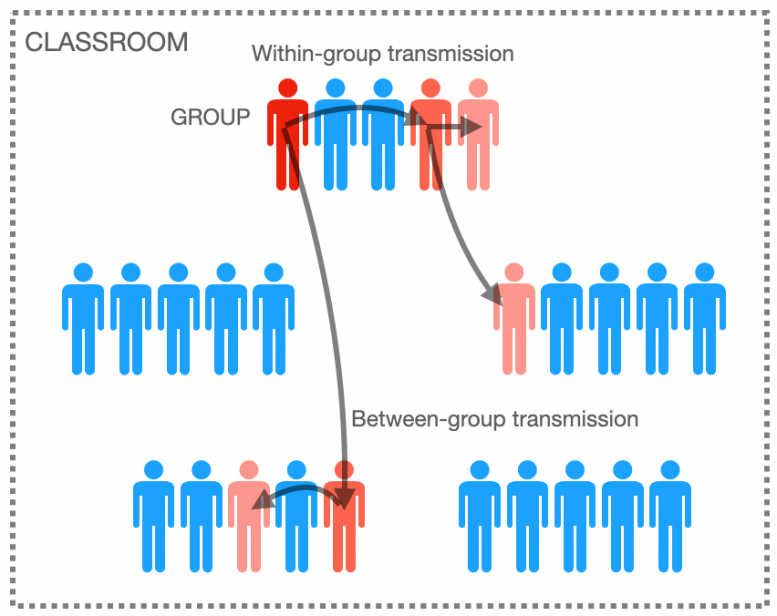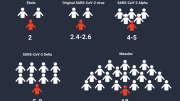
Depiction of classroom transmission. The classroom has five groups of students who are considered close contacts. The index case (dark red) attends a class in which all other students are susceptible. The index case may infect some other students directly (medium red), and they may go on to infect others (pale red). Transmission can occur within groups and between groups (at a lower rate). Credit: Paul Tupper (CC BY 4.0)
Regular monitoring may be only way to prevent large COVID-19 outbreaks in schools. New simulations suggest that waiting until a student tests positive is too late for prevention.
A new study examines factors that underlie COVID-19 outbreaks in schools and suggests that large outbreaks can only be prevented with regular monitoring of everyone in the school setting. Paul Tupper and Caroline Colijn of Simon Fraser University, Canada, present these findings in the open-access journal PLOS Computational Biology.
Data from around the world show highly varied outcomes for COVID-19 clusters in schools, with some settings having many large outbreaks and others having few serious problems. The factors underlying this variability have been unclear, as have the most effective strategies for preventing large outbreaks.
To better understand COVID-19 dynamics at schools, Tupper and Colijn used a mathematical model to simulate disease spread in the classroom. The simulations incorporated two factors that could affect outbreak severity: differences between infected individuals in how easily they can transmit the disease to others, and differences in transmission rates for different environments and activities.
The simulations showed that, in a classroom with 25 students, anywhere from 0 to 20 students might be infected after exposure, depending on even small adjustments to transmission rates for infected individuals or environments.
The researchers then simulated the effects of different protocols to prevent large clusters. They found that, in scenarios with high transmission rates, preventive actions (such as closing down a whole class) that only took effect after a student developed symptoms and tested positive were too slow to prevent large outbreaks. In fact, large clusters could only be prevented with regular monitoring of everyone in the setting, for example with pooled rapid testing on site.
“We found that waiting until a student develops symptoms and tests positive is too slow a response, even though this was the method used in many jurisdictions to prevent COVID-19 transmission,” Tupper says. “Screening students without symptoms works quite well in our model and could also be applied in workplaces or shared living accommodations.”
The scientists plan to incorporate additional data and expand their model to explore the best strategies to prevent spread after a case is detected, both in classrooms and other settings.
Reference: “COVID-19 in schools: Mitigating classroom clusters in the context of variable transmission” by Paul Tupper and Caroline Colijn, 8 July 2021, PLOS Computational Biology.
DOI: 10.
Funding: PT was supported by a Natural Science and Engineering Research Council (Canada) Discovery Grant, RGPIN-2019-06911. They did not play any role in the study design, data collection, and analysis, decision to publish, or preparation of the manuscript. CC was supported by a Genome BC grant, COV-142. They did not play any role in the study design, data collection, and analysis, decision to publish, or preparation of the manuscript.









Be the first to comment on "Here’s What Scientists Say Is Needed to Prevent Large COVID-19 Outbreaks in Schools"